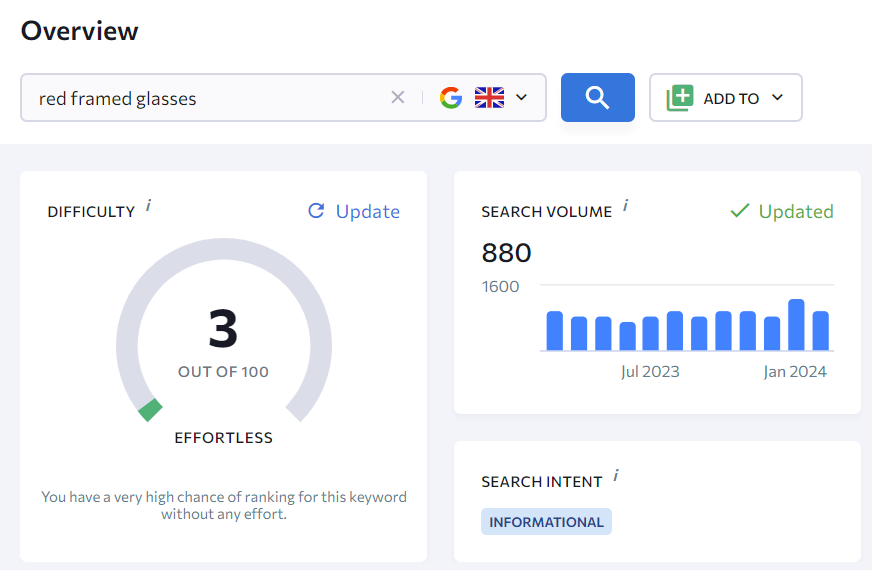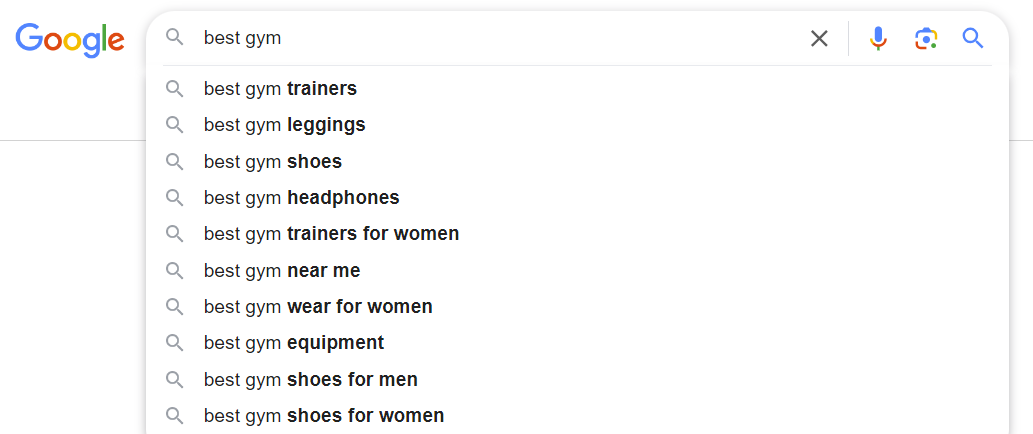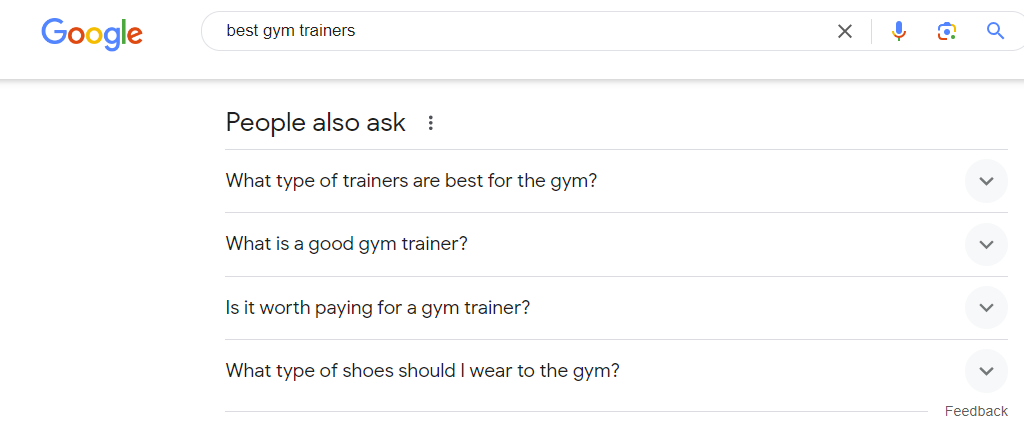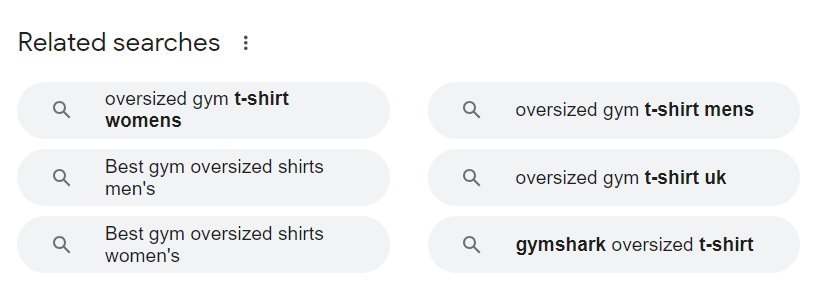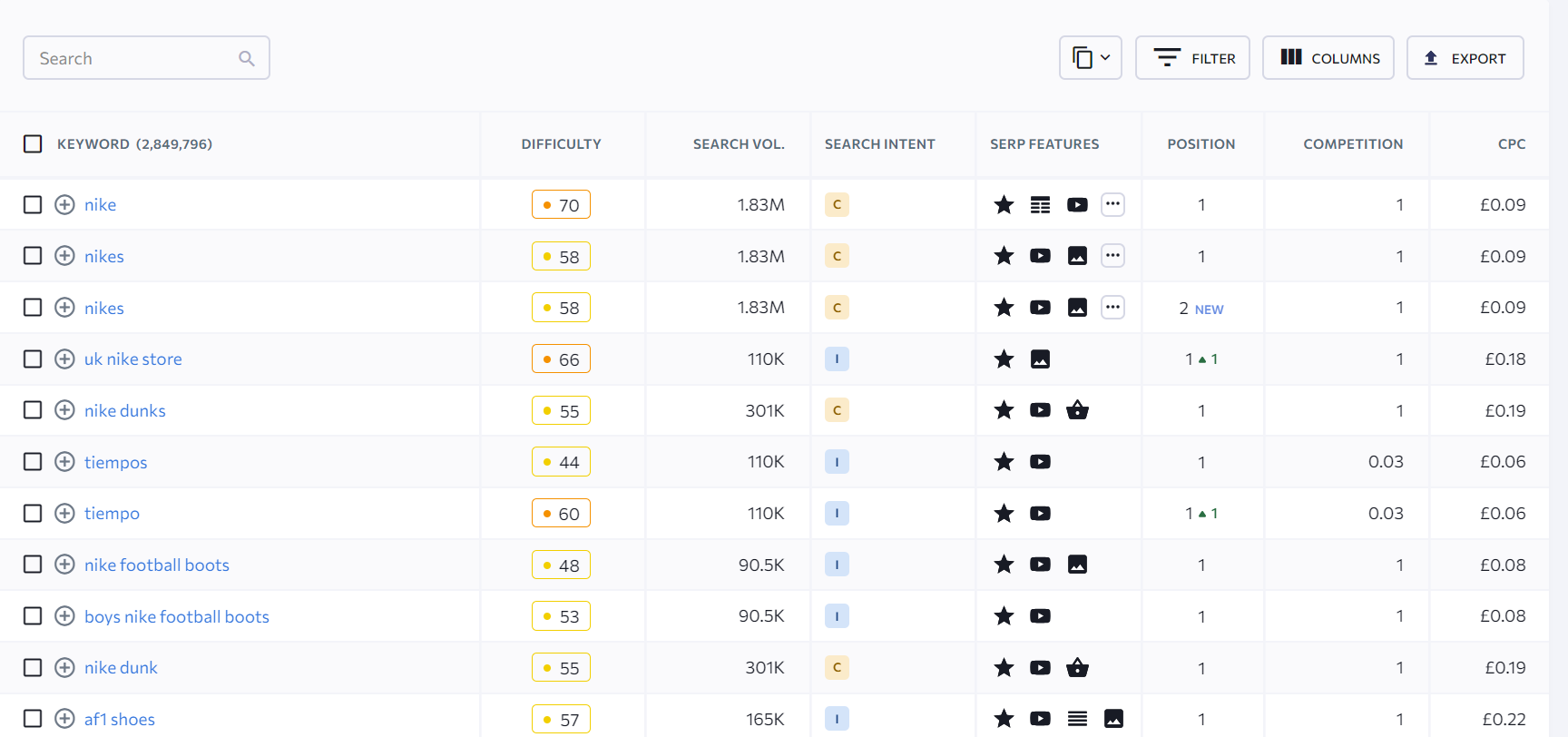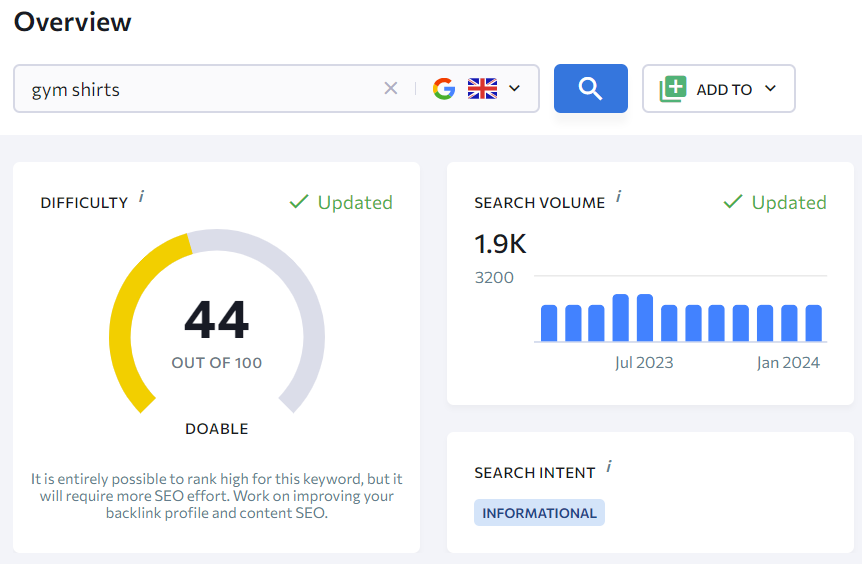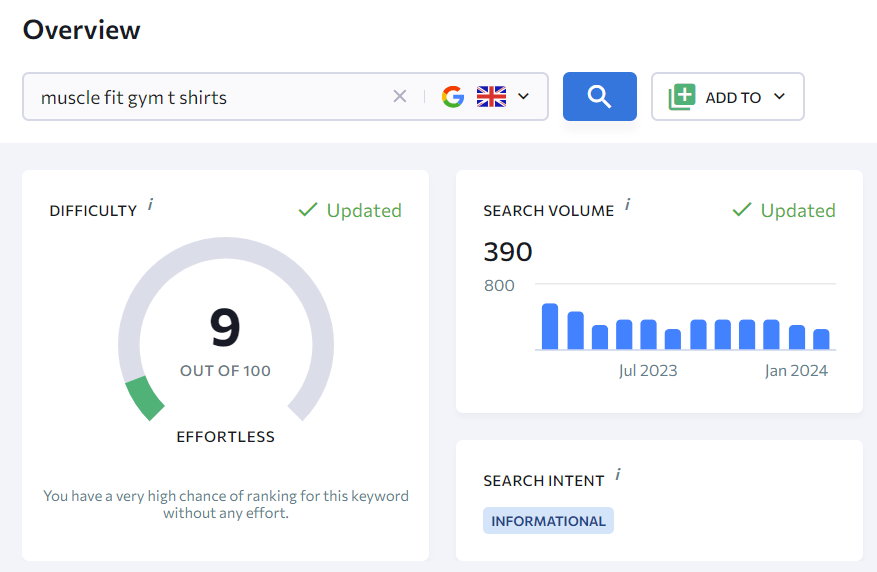Keyword research is the most important part of any great SEO campaign.
It allows you to understand the terms and phrases your target audience is searching for, so you can optimise your website’s content and strategy. This ultimately drives organic traffic and boosts your search engine rankings.
Google is like a keyword detective. It scours your website to figure out what you’re all about. Whether you’re running a bakery or selling surfboards, keywords are like your secret weapon for getting noticed by people who’ve never even heard of you.
In today’s digital world, keywords are your ticket to reaching the masses of Google searchers. With the right keywords, you can skyrocket your brand’s visibility to infinity and beyond!
What is keyword research?
Keyword research involves the practice of discovering, analysing, and implementing the phrases people use when looking for information on the internet.
This is often done on a platform, such as SE Ranking, which gives you the search volume for certain keywords, along with a difficulty score (how difficult it would be to rank for that keyword with your site.)
For example, let’s say you were a business that sold glasses online, and you had just released a new catalogue of red glasses. Your keyword research should be based on keywords surrounding red glasses.
The above is the data that SE ranking shows for the keyword “red framed glasses”.
Search Volume – number of times a particular keyword is entered into a search engine over a specific period – typically monthly.
Difficulty – The level of competition and challenge associated with ranking for a specific keyword.
The search volume is 880, which shows there is interest in this keyword.
The difficulty is 3, which means, that if you implement the keyword into your site content, you have a very high chance of ranking for this keyword.
However, it is also very important to consider the search intent – the purpose behind a user’s online search query. For this keyword, the search intent is informational and also probably commercial.
When targeting a keyword with informational search intent, your main goal should be to provide valuable and relevant information to users.
This could involve answering frequently asked questions, creating a blog article, or providing content on a webpage.
Why is keyword research so important?
Alright, picture this: You’ve got this amazing website, right? You’ve poured your heart and soul into it, but there’s just one problem… nobody’s finding it! This is where keyword research can come in handy to better understand why.
When you know what words and phrases people are searching for on Google, you can tailor your website content to match. Think of it as speaking the same language as your audience.
But keyword research isn’t only about finding highly searched and relevant words to put into content for your site – it serves as a market research tool, offering your business fresh concepts and a deeper understanding of your industry.
Keyword Research Process
Keyword research can be broken down into 3 main stages, which cover its process. Before beginning the process, brainstorm roughly 10 keywords that include all the key aspects of your business, products, or services.
Consider the core offerings, unique selling points, and any specific features or benefits that set your business apart.
Think about the pain points or problems your target audience may be seeking solutions for. Do this by considering which topics are likely to be searched by your target audience and which ones you want your business to be discoverable for.
By identifying these topics, you can better understand the broader themes and subjects that resonate with your audience.
This list will serve as a roadmap for discovering relevant keywords and sub-topics within each keyword, setting the stage for a successful keyword research strategy.
Discovering the Keywords
Keyword Research Tools
One such tool is Google Keyword Planner, a powerful resource provided by Google that offers a comprehensive database of keyword ideas and search volume data. By putting relevant keywords or phrases into the Keyword Planner, you can generate a list of related terms along with their average monthly search volumes.
While also being free to use, it is the only tool with accurate search volume data – every other tool is a predictive model based on the results from Google.
This information enables you to prioritise keywords based on their popularity and potential impact on your website’s traffic.
In addition to search volume data, Google Keyword Planner also provides insights into keyword trends and competition levels, helping you gauge the level of competition for specific keywords and identify emerging trends that you can capitalise on.
For instance, if you notice a sudden surge in search volume for a particular keyword related to your industry, it may indicate a growing interest or demand among users.
This can prompt you to use that keyword in your content strategy.
Google Suggestions
We’ve all seen how Google offers suggestions in the search bar when we’re looking for something – this is based on the popularity of previous searches.
Autocomplete offers the suggestions that Google has given you. This can give good inspiration for keywords to target.
You can try different combinations with different letters, for example:
- best gym a…
- best gym b…
- best gym c….
The ‘people also ask’ section appears and gives suggestions for related topics in a question format. This can serve as inspiration for longer, more specific keywords – long tail keywords. Or, question-type keywords that you may want to use in an FAQ section, for example.
Finally, you can look at the bottom of the page and find the ‘Related Searches’ section where they provide suggestions for you to click, which derive from the popularity of each search.
This example comes from searching “best gym oversized shirts”.
Analysing Competitors
This provides insights into the strategies that are working within your industry. You can gain a better understanding of the landscape and identify opportunities to differentiate yourself.
There are many tools you can use to analyse competitors such as SEMRush, Moz, Ahrefs and SE Ranking. For the example, we’ll use our preferred tool, SERanking.
If you were competing with Nike for example (don’t even think about it!) you can see the list of keywords that they are ranking for.
You can see what keywords they’re ranking for:
You can see what keywords you can get inspiration from, and see if you’d want to try and implement them into your keyword strategy (maybe not many from Nike, or any).
Analysing the Keywords
Understanding Your Audience
This goes beyond basic demographics; it involves delving deep into their behaviours, preferences, and pain points.
This deeper understanding allows you to understand your audience effectively.
By putting yourself in the user’s shoes, you can anticipate their search intent and provide content that not only meets but exceeds their expectations.
Let’s consider a user searching for “how to make sourdough bread at home.” The user’s intent behind this query is likely informational; they’re interested in learning the process of making sourdough bread from scratch.
However, a bakery might assume that users searching for sourdough bread-related keywords are interested in purchasing pre-made sourdough loaves. As a result, the bakery’s website might feature product listings, promotions, and calls to action to buy their sourdough bread, with limited or no informational content about the process of making sourdough bread at home.
This mismatch in intent can lead to frustration for the user, who may leave the site in search of the information they were initially seeking, and missed opportunities for the bakery to provide valuable content that establishes them as an authority in their niche.
By understanding your audience and their search intent, you can foster stronger connections with them and drive engagement and loyalty.
Long Tail Keywords
It’s important to explore long-tail keywords, which are longer and more specific phrases that typically have lower search volumes but higher conversion rates. Long-tail keywords often reflect the specific needs or intentions of users, making them highly valuable for attracting highly targeted traffic to your website.
For example, as an online sports apparel business, instead of targeting a broad term like “gym shirts,” you might focus on long-tail keywords like “muscle fit gym t shirts”.
As you can see above, “gym shirts” has far more search volume, but also a lot more competition (shown by the difficulty score).
So, by incorporating the long-tail keyword into your content strategy, you can reach users who are actively seeking the specific products or information you offer, increasing the likelihood of conversion and engagement.
Analysing the Keywords
Keyword Popularity
A keyword’s popularity directly influences its search volume – higher search volumes suggest greater demand and interest among the target audience.
This allows you to capitalise on this demand by incorporating popular keywords into your site.
Popular keywords often correlate with higher levels of competition in search engine results pages (SERPs), as multiple websites vie for visibility and traffic using the same or similar keywords.
Additionally, the popularity of a keyword reflects its relevance and alignment with user intent, as users are more likely to search for terms that resonate with their interests, needs, or inquiries.
By targeting popular keywords that closely match the content or offerings of your website, you can attract highly qualified traffic and improve the overall user experience.
This can lead to an increased likelihood of conversion.
Keyword Difficulty
Keyword difficulty refers to the level of competition and challenge associated with ranking for a particular keyword in search engine results pages (SERPs).
Understanding keyword difficulty can help you gauge the feasibility of ranking for specific keywords based on factors such as domain authority, backlink profile, content relevance, and competition from other websites.
High keyword difficulty indicates intense competition and may require significant time, resources, and expertise to achieve desirable rankings. Conversely, low keyword difficulty suggests less competition and presents an opportunity for quicker and easier wins in organic search rankings.
By conducting keyword difficulty analysis, you can prioritise your SEO efforts and focus on targeting keywords that offer the best balance between search volume and competition level.
Considering keyword difficulty helps you identify niche opportunities and long-tail keywords with lower competition but high relevance to your target audience.
While these keywords may have lower search volume individually, collectively they can drive significant organic traffic and attract qualified leads or customers.
Search Intent
Search intent refers to the underlying motivation or purpose behind a user’s search query, whether it’s:
Informational – Desire to gather information, learn, or gain knowledge about a specific topic, question, or issue.
Navigational – Intention to find a specific website or web page, often by entering the brand name or URL into the search engine.
Transactional – Intention to complete a specific action, such as making a purchase, signing up for a service, or downloading a file.
Commercial – Researching products or services with the intention of making a purchase, but are not yet ready to buy.
Local – Seeking information or businesses within a specific geographic area, such as restaurants, stores, or services near their location.
By understanding search intent, you can tailor your content, optimise your website, and align your messaging to meet the specific needs and expectations of users at different stages of the customer journey.
Examining search intent helps you ensure that the content you create or optimise aligns with the intent of users’ search queries.
For instance, if a keyword primarily reflects informational intent, you can develop informative and educational content, such as blog posts, articles, or how-to guides, to address those inquiries effectively.
Conversely, if a keyword signals transactional intent, you can optimise your product pages, landing pages, or call-to-action (CTA) messaging to facilitate conversions and drive revenue.
By identifying the underlying motivations behind users’ search queries, marketers can tailor their content and messaging to provide relevant and valuable information, solutions, or experiences that address users’ pain points, interests, or desires.
Implementing the Keywords
Finding the Balance
Before implementing any keywords, finding the balance between keywords of different lengths is very important.
High-volume keywords, typically consisting of one or two words, have the potential to generate a lot of traffic to your website due to their broad appeal and large search volume. By targeting these keywords, you can increase your visibility in search engine results pages (SERPs) and attract a wide audience to your content or products.
However, due to their high competition, it will be very difficult to rank highly using these keywords, especially when starting out.
Long tail keywords are often less competitive due to their lower search volume and high specificity. This allows you to target highly relevant, qualified leads and you are likely to convert.
By incorporating both high-volume keywords and long-tail keywords, you can create a well-rounded keyword strategy that maximises your website’s visibility, relevance, and ultimately, your conversion rates.
Keyword Stuffing
This is something you should avoid.
Keyword stuffing is overloading your content with excessive keywords in an attempt to manipulate search rankings.
Before the Panda 2011 update from Google, sites were able to keyword stuff and manipulate Google to rank higher.
As Google wants user experience to be the best it can be, they have removed the ability for sites to do this.
If you keyword stuff now, this can have a detrimental impact on user engagement and may even result in penalties from Google.
Instead, focus on creating high-quality, valuable content that naturally includes keywords in a way that enhances readability and relevance for your audience.
Content Creation
Content creation is the cornerstone of any successful digital marketing strategy. By producing high-quality, informative, and engaging content that aligns with your target keywords, you not only cater to the needs and interests of your audience but also enhance your website’s visibility and authority in search engine results.
Blog Posts
Blog posts offer a platform for exploring topics in-depth, addressing common questions, and providing valuable insights that establish your expertise within your industry. Articles allow for a more formal and structured approach to conveying information, making them ideal for in-depth analysis, industry news updates, or thought leadership pieces.
Product Descriptions
Product descriptions play a crucial role in e-commerce websites, providing detailed information about your products or services while putting in relevant keywords to improve search visibility and drive conversions.
FAQ Pages
Frequently Asked Questions (FAQ) pages address common queries and concerns related to your products, services, or industry. Organising information in a structured FAQ format helps users quickly find answers to their questions and improves overall user experience.
FAQ pages also allow you to target specific question-related keywords.
Informational Page
Crafting high-quality, informative content that addresses the chosen keywords and provides value to your audience is an effective approach to targetting keywords.
Structuring the content logically, using headers, bullet points, and concise paragraphs improves readability and user experience which has further benefits to your ranking.
Other Ways
Alongside content creation, there are a handful of other places to implement your keywords.
- Site title.
- SEO title and page title.
- Headings (e.g., h1, h2).
- Body of text.
- Categories.
- SEO site, page, and item descriptions.
- URL page slugs.
- Domain name.
Conclusion
Keyword research is the foundation for any effective SEO strategy. It’s not just about ranking higher; it’s about understanding your audience’s intent and creating content that resonates. With diligent research and strategic implementation, you can unlock short-term and long-term success in the digital world.


